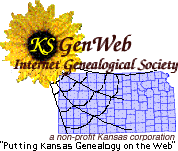Johnson County History
Johnson County, Kansas Local History
The area now comprising Johnson County was originally a part of the Shawnee Indian reservation, created by the St. Louis Treaty in 1825. In 1829, the Reverend Thomas Johnson, a Methodist missionary, and his wife settled in the county and taught the Shawnees. The Baptist mission was founded in 1831 and the Quaker mission in 1834. In 1836, the remaining Shawnees were removed to the area from Auglaizo and adjoining counties in Ohio. The Shawnee Mission, known as Shawnee Manual Labor School, was founded in 1838 by the Reverend Johnson. (While there is no formal town today called Shawnee Mission, there is still an area & a school district in Johnson county known as the Shawnee Mission district, which is statistically one of the best school districts in the country, by the way - ed.).
On May 11, 1854, the same year in which Congress adopted the act organizing Kansas Territory, the Shawnees ceded to the United States 1,000,000 acres - all but 200,000 acres of their land, and the area was thrown open to settlement.
Johnson County was created in 1855 by an act of the first territorial legislature, which sat at Shawnee Mission. The county received its name from the Reverend Thomas Johnson, founder of Shawnee Mission and member of this first legislative body. This legislature had first convened at Pawnee on July 2, 1855, but adjourned to the mission after pro-slavery leaders ousted all other members. Thus Shawnee Mission became the territorial capital. At the close of the session, Lecompton, in Douglas County, became the permanent territorial capital.
Gum Springs, now the site of the City of Shawnee, was named the first county seat by the legislature of 1855, and the county tribunal held its initial meeting there in 1857. Olathe, the present seat of government, was first chosen as the county capital in an election early in 1858. But on the grounds that the territorial laws provided that elections to change county seats should be held under order of the chief executive of the territory, Governor Denver held this election illegal and ordered the county seat returned to Gum Springs. The removal was made on June 6. Olathe was chosen as the seat of the county government at a second election in October of the same year. Olathe was declared the permanent seat by legislative act in 1859.
In the ensuing territorial period, lasting until Kansas received statehood in January, 1861, and the outbreak of the Civil War, Johnson County was the scene of a struggle between the pro-slavery and anti-slavery factions, but its citizens escaped some of the suffering of settlers in other counties until after the outbreak of the war. Quantrill's band raided Olathe on September 6, 1862. Two persons were killed and stores and homes invaded and robbed. Nearly the entire town of Shawnee was burned by a second raid in the county by Quantrill on October 17, 1862. However, after the summer of 1863, a patrol of citizens were successful in keeping out invaders.
The orginal boundaries of Johnson County, fixed in 1855, were as follows: Beginning in the main channel of the Kansas (Kaw) River, at the point where said channel crosses the Missouri line; thence south on said Missouri line 26 miles; thence west 24 miles; thence north to the main channel of the Kansas (Kaw) River; thence down said channel to the place of beginning. In 1857, the southern boundary of the county was more definitely described by a legislative act, which declared this boundary to extend from the Missouri line in the corner of fractional sections 14 and 23 in township 15, south, range 25, east; west along section line to the corner of sections 14, 15, 22 and 23; township 15, south, range 21, east.
The present boundaries were established in 1859 when the territorial legislature detached a triangular stip consisting of that portion of the county lying north of the line dividing townships 11 and 12, east of range 20, and also bounded by the Missouri line and Kansas River. This act reduced the length of the east county boundary to 21 miles. The detached area was made a part of Wyandotte County, which was created by the same act.
In 1858, Johnson County had 15,890 inhabitants. In 1936, the population was 28,324. The 1990 population of Johnson County was 355,054, making it one of the fastest growing counties in the United States.
Bibliography: "Inventory of County Archives of Kansas", published 1936 ; US Census Data .



